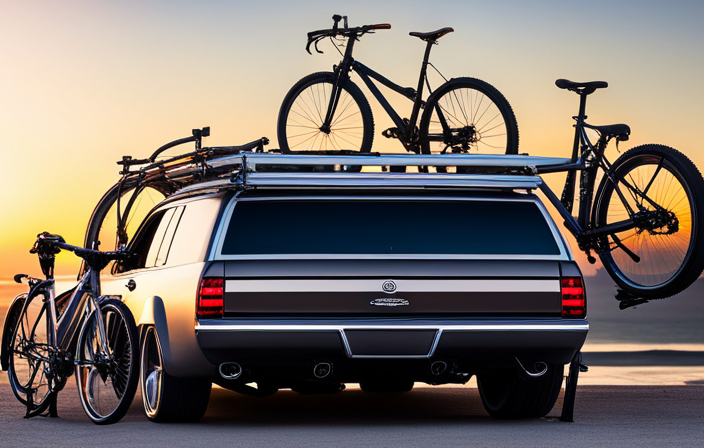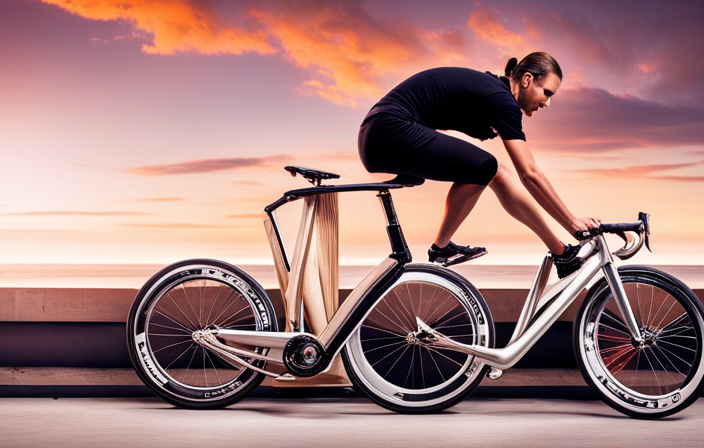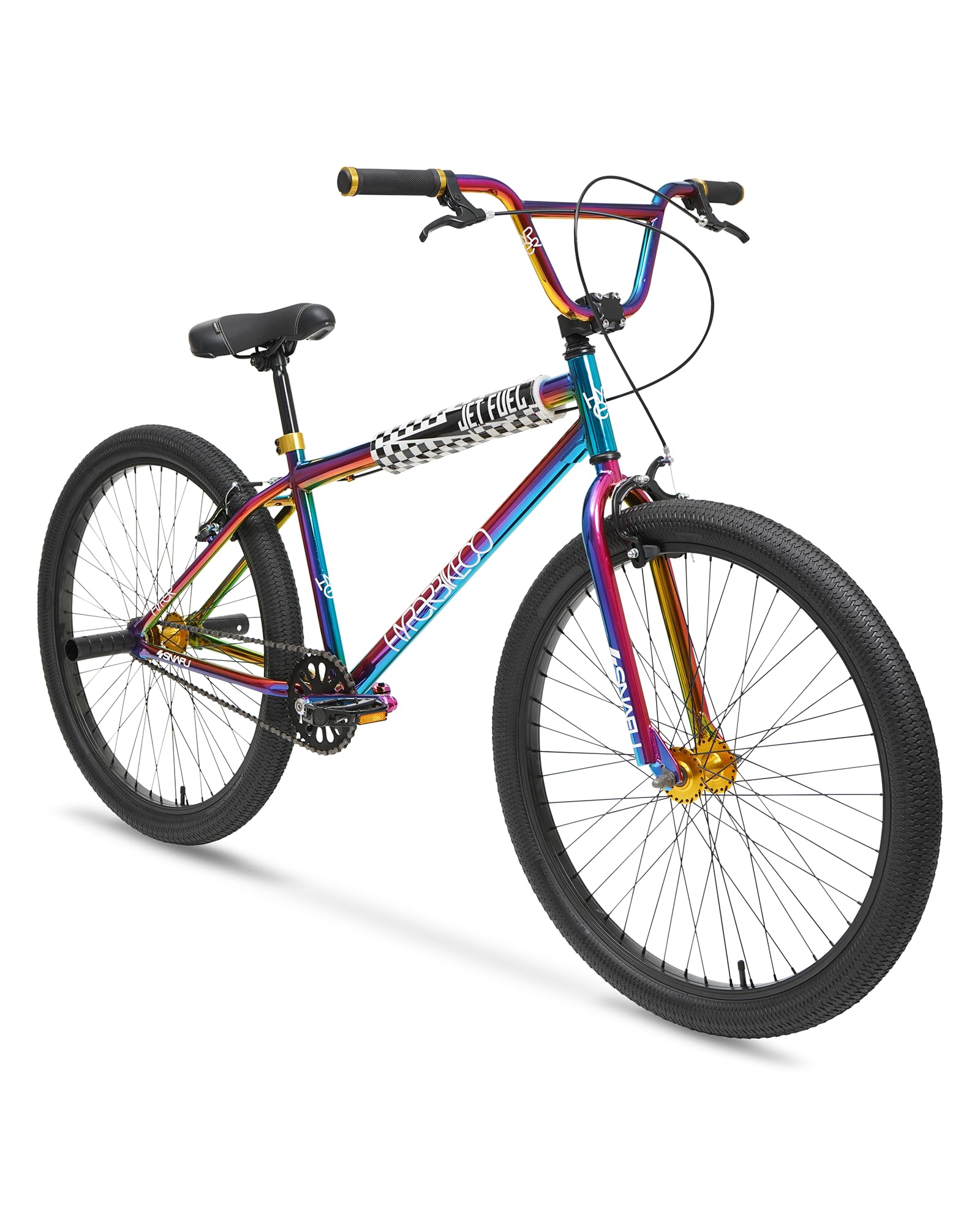Beginners Guides
How Much is the Hybrid Bicycle Weight Limit? – A Guide for Heavier Riders
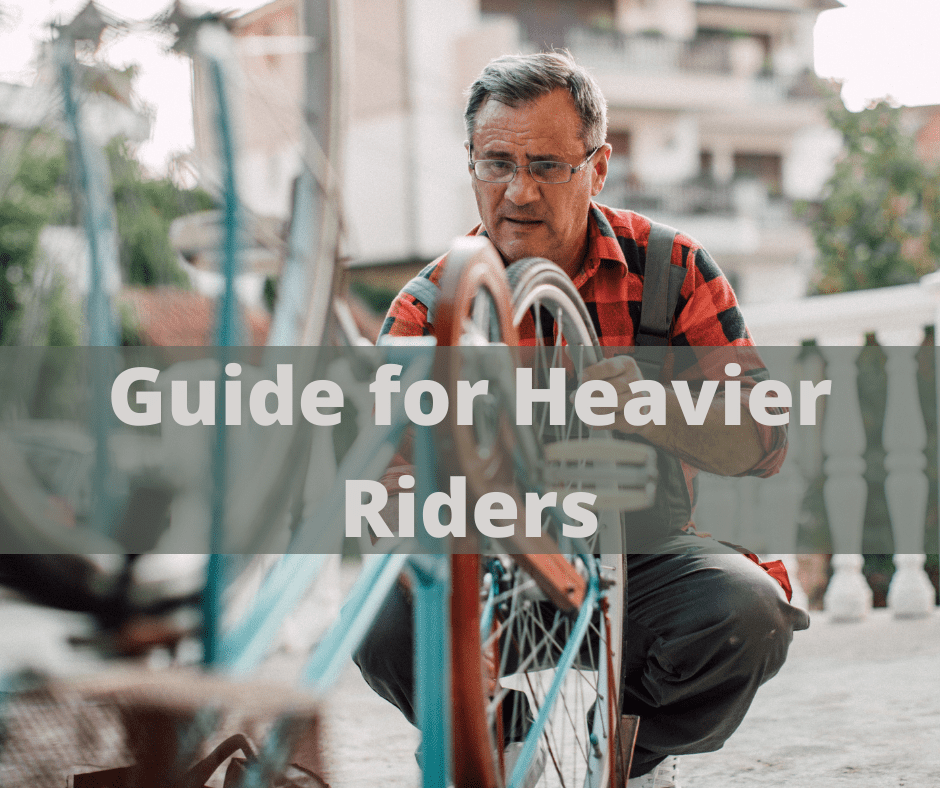
Larger cyclists often experience mixed feelings towards biking. The thrill and pride from cycling are undeniable, yet the discomfort can be frustrating. If you’re among the heavier cyclists, understanding the challenge of finding a bike that’s both comfortable and suitable for you is nothing new. But there’s no need to worry – we’re here to help! This guide will explore hybrid bicycles suitable for heavier riders and their weight capacity. Additionally, we’ll offer advice on selecting the ideal hybrid bicycle tailored to your needs.
Hybrid bikes are popular for recreational riders, as they offer a comfortable ride without sacrificing performance.
Hybrid bikes are also a great option for heavyweight riders, as they are designed to accommodate the higher weight and provide a comfortable ride. For overweight riding enthusiasts, hybrid bikes offer the perfect solution – a bike that is designed for their physiology and comfort level, without sacrificing performance. With all of these factors considered, it’s no wonder that hybrid bikes are the preferred choice for recreational and heavyweight riders alike.
How Much Weight Can a Hybrid Bike Carry?
A hybrid bike’s weight limit depends on the frame, components, and other features. Most bikes have a maximum load capacity of 300 to 350 pounds. It is important to follow the weight limit for a safe ride. Hybrid bikes are designed to accommodate tall, short, normal, and overweight riders.
The bike’s weight limit is important for obese riders. Bikes with a higher weight limit can accommodate more overweight riders. Follow the manufacturer’s weight limit to ensure a safe and secure ride.
It is well-known that bicycles have weight limits that riders must adhere to. If a heavy rider exceeds the load limit, it will cause the bicycle to lose efficiency and may even cause irreparable damage to the rider. For example, if a rider weighs more than 300 pounds, the structure of the bicycle will be unable to handle the weight and may collapse.
Additionally, the rider may suffer from health complications such as broken bones or muscular injuries.
A hybrid bike is a great choice for those who want the best of both worlds. Hybrid bikes are designed as two-in-one bikes, meaning they are a great and wholesome blend of the capabilities of both mountain bikes and road bikes.
They usually have thinner tires than mountain bikes, which makes them quicker on pavement, but thicker tires than road bikes, which gives them better traction and stability on rough terrain. Additionally, hybrid bikes often have features that are specific to either mountain biking or road biking, such as suspension systems and gear ratios. This makes them more versatile than either type of bike and able to handle a wide range of riding conditions.
Whether you’re looking to ride on the road or off the beaten path, a hybrid bike is a great option. Therefore, it is important for riders to be aware of the weight limit of their bicycle and make sure not to exceed it. By doing so, they can avoid potential losses and keep themselves safe while riding.
What to Consider when Selecting the Best Bike for Heavy Riders?
Heavyweight riding champs are a different breed when it comes to bicycling. They require a bike that can sustain their weight and still perform at a high level.
This means that the frame material, design, tires, and brakes all need to be up to the task. With so much weight on the bike, the frame needs to be able to handle the stress without flexing or breaking. The same goes for the tires; they need to be able to grip the road and provide good traction.
And finally, the brakes need to be able to stop the bike quickly and safely. When all of these factors come together, you have a bike that can perform at a high level even with a heavyweight rider on board.
There are, however, a few basic things that remain the same for all bikes and must be considered regardless of the frame type you want.
The most important thing to keep in mind is the bike’s weight limit. Most manufacturers have a weight limit of 250 pounds, but there are some that can accommodate riders up to 300 pounds. If you’re a heavy rider, it’s important to choose a bike that can handle your weight.
Another thing to consider is the bike’s tires. Some tires are designed for speed, while others are designed for traction and stability. If you’ll be riding on rough terrain, you’ll need tires with good tread to prevent slipping and sliding. Finally, make sure the bike you choose has a comfortable seat. A padded seat will help reduce soreness and make your rides more enjoyable.
A road bike is one of the most essential purchases a cyclist can make. Not only do they provide a means of transportation, but they also allow us to stay in shape and enjoy the outdoors.
However, with so many different brands and models on the market, it can be difficult to know which one is right for you. If you are a heavy rider, there are a few things you should keep in mind when choosing a road bike. First, look for a bike made from high-quality materials.
This will ensure that your bike is able to withstand the extra weight. Second, pay attention to the components of the bike. Make sure that the brakes and gears are up to the task of supporting your weight. Finally, take the time to test ride the bike before you make your purchase. This will give you a chance to make sure that it is comfortable and easy to ride. By keeping these things in mind, you can be sure to find a road bike that will suit your needs and help you enjoy cycling for years to come.
Material of Frame
The material of the frame is important for many reasons. It can add strength and stability to the overall structure of the house, and it also plays a role in terms of insulation and weatherproofing. In order to get the most out of your frame, it’s important to choose a material that will meet all of your needs.
When it comes to choosing a frame for your bicycle, there are a few things you need to take into account. The first is the material. Aluminum, steel, and carbon are all popular choices, but each has its own advantages and disadvantages.
Aluminum is lightweight and strong, but it is also relatively expensive. Steel is cheaper and just as strong as aluminum, but it is also heavier.
Carbon is the lightest and strongest option, but it is also the most expensive. The second thing you need to consider is the size of the frame. Make sure to choose a size that will be comfortable for you to ride for long periods of time. Finally, you need to decide on a style.
There are road bikes, mountain bikes, and hybrid bikes, each of which has its own benefits. Once you have taken all of these factors into consideration, you will be able to choose the perfect frame for your needs.
Your New Bike Frame
If you’re in the market for a new bike frame, you have a few different materials to choose from. Aluminum is a popular choice because it’s lightweight and durable. Steel is another option that’s known for its durability.
And carbon is also a good choice if you’re looking for something that can withstand a lot of weight. So which material is right for you? It really depends on your needs and budget. If you’re looking for something that’s lightweight and durable, aluminum is a great choice. If you need something that can withstand a lot of weight, then steel or carbon would be a better option. Ultimately, it’s up to you to decide which material is best for your needs.
Wheels and Tires
Those who enjoy mountain biking know that it can be a great workout as well as a fun way to explore the great outdoors. However, one common complaint amongst heavyweight bikers is that mountain bikes can often be unstable, making it difficult to stay on the trail.
This is usually due to inadequate wheels and tires – if they are not of the proper diameter and width, it can make it tricky to navigate sharp turns or steep roads. Disc brakes can help to alleviate some of these stability issues, as they provide better stopping power. Additionally, wider tires will also provide more stability and grip, so you can feel confident while out on the trails. By taking these measures, you can enjoy a stable and safe ride no matter where your adventure takes you.
Suspension
For anyone who has ever attempted a long bike ride, it is quickly apparent that not all bicycles are created equal. Those riders who are on the heavier side often find it more difficult to pedal for extended periods of time, particularly on rough roads.
The bumps and indentations that are common on less-than-perfect pavement can put stress on muscles and make the ride downright uncomfortable. To avoid this type of situation, it is important to choose a bicycle that has a reliable suspension assembly installed.
This suspension can help to diminish the jerks that are caused by potholes or other roughness in the ground, resulting in a smoother ride over every type of road. This makes it possible for the biker to truly enjoy the experience, regardless of the surface on which they are riding.
Brakes
When it comes to riding a bike, safety is always a top priority. And one of the most important safety features on a bike is the brakes. After all, if you can’t slow down or stop when you need to, you’re putting yourself at risk for an accident.
That’s why it’s so important to make sure your bike is equipped with good brakes. Disc brakes are a great option for hybrid bikes. They’re highly sensitive to your controls, which means they’ll respond quickly and accurately when you need to slow down or stop. So if you’re looking for a safe and reliable braking system for your hybrid bike, disc brakes are a great choice.
Hybrid Bicycle Frames for Heavy Riders
There are three main materials used in the construction of hybrid bike frames: aluminum, carbon fiber, and titanium. Each material has its own advantages and disadvantages, so it’s important to choose the right one for your needs.
Aluminum is the most commonly used material for bike frames. It’s lightweight and affordable, making it a good choice for entry-level bikes. However, aluminum is not as durable as other materials and is more susceptible to damage from impact.
Carbon fiber is another popular choice for bike frames. It’s lighter than aluminum and very strong, making it ideal for racing bikes. However, carbon fiber is also very expensive, so it’s not a good choice if you’re on a budget.
Titanium is the strongest of all the materials used for bike frames. It’s very light and durable, making it a good choice for high-end bikes. However, titanium is also very expensive, so it may not be the best choice if you’re on a budget.
Hybrid Wheels for Heavy Riders
When it comes to choosing the right wheels for your hybrid bike, there are a few key factors to keep in mind. First, consider the size of the wheel. The most common sizes are 700C, 26 inches, and 29 inches. Each size has its own advantages and disadvantages, so it’s important to choose the one that best suits your needs.
For example, 700C wheels have a higher potential to roll over obstacles like gravel and bumps, while 26-inch tires are better suited for mountain biking for heavyweight riders. Once you’ve decided on the right size, it’s also important to consider the material of the wheel.
The most common materials are aluminum and carbon fiber. Aluminum is less expensive but also less durable, while carbon fiber is more expensive but more durable. Ultimately, it’s important to choose the material that best fits your budget and riding style. With a little bit of research, you can find the perfect wheels for your hybrid bike.
Conclusion
When it comes to choosing a hybrid bike, there are a few key factors to keep in mind. First, consider the size of the wheel. The most common sizes are 700C, 26 inches, and 29 inches. Each size has its own advantages and disadvantages, so it’s important to choose the one that best suits your needs.
When it comes to choosing a bicycle, it is important to consider the different features and components that will be best suited for your needs. For instance, if you are a heavyweight rider, you will want to choose a mountain bike that is made from durable materials and has sturdy wheels.
Additionally, it is important to consider the suspension and brakes when selecting a bicycle. The suspension helps to absorb shocks, while the brakes provide instant stopping power.
Just like any other vehicle, a bicycle has a weight limit that shouldn’t be exceeded. The weight limit is usually determined by the manufacturer and it’s there for a reason – to keep you safe. If you regularly ride with a heavy load, it’s important to check that your bike can handle the extra weight.
The same goes for the load capacity – this is the maximum weight that can be carried on the bike, including the weight of the rider. Exceeding either of these limits can put you at risk of an accident.
By taking the time to consider all of the different features and components of a hybrid bicycle, you can be sure to find the perfect bike for your needs.
Beginners Guides
Mastering Bicycle Gear Use on Flat Roads
Uncover the secrets to mastering bicycle gear use on flat roads and revolutionize your cycling performance like never before.

Have you ever wondered if mastering the use of bicycle gears on flat roads could significantly improve your cycling performance? Understanding the intricate gear mechanisms and honing efficient gear changing techniques can truly elevate your riding experience.
But there's more to it than just shifting gears; optimal gear selection and cadence play crucial roles in maximizing your cycling efficiency.
Stay tuned to uncover valuable tips and tricks that will help you become a gear-shifting pro on flat terrains.
Key Takeaways
- Optimize gear ratios with front chainrings and rear cassette for efficient flat road cycling.
- Use precise gear changes to maintain a consistent cadence and power output.
- Avoid common gear mistakes like high gears and cross-chaining for improved performance.
- Experiment with different gear combinations to find the ideal balance of comfort and efficiency.
Gear Mechanism Basics
Exploring the intricacies of the gear mechanism on road bikes reveals the fundamental components that dictate pedaling efficiency and performance on flat terrain. The gear system comprises the front chainrings attached to the pedals and the rear cassette, with its array of cogs offering various resistance levels. The front chainrings play a pivotal role in major speed adjustments, while the rear cassette allows for subtle tweaks to optimize pedaling on flat roads.
When shifting the front chainring, cyclists experience notable gear ratio modifications, significantly impacting the required pedaling effort. On the other hand, adjusting the rear cassette with the appropriate lever enables riders to finely tune resistance levels for maximum efficiency on flat terrain. This manipulation of gears is crucial in maintaining an ideal cadence and power output, ensuring a smooth and effective riding experience.
Understanding the interplay between the chain, cassette, front, rear, lever, and cogs is essential for mastering gear utilization and enhancing cycling performance on flat roads. By grasping these gear mechanism basics, cyclists can unlock the full potential of their road bike and enjoy a liberating and empowering ride.
Efficient Gear Changing Techniques

When optimizing gear changes for flat road cycling, precision in adjusting the rear cassette with the right brake lever is key to maintaining pedaling efficiency and speed control. On flat roads, using the small lever located behind the right brake lever allows for easier and more efficient shifting of the rear gears. By utilizing the right brake lever along with the small lever, cyclists can fine-tune the gearing with their right hand, ensuring smooth gear changes and optimal pedaling efficiency.
Efficient gear changing techniques on flat roads involve utilizing the right lever for precise adjustments to the rear cassette. This method enables cyclists to make minor pedaling speed changes without compromising their momentum. By mastering the art of adjusting the rear gears with the right brake lever, riders can experience a comfortable and efficient cycling experience, where gear changes happen seamlessly, enhancing the overall enjoyment of the ride. Smooth gear changes are essential for maintaining a consistent cadence and achieving a balanced power output on flat terrains.
Optimal Gear Selection Tips

What gear ratios are most suitable for flat road cycling to ensure optimal performance and efficiency? When cycling on flat roads, it's essential to select the right gears to maximize your efficiency and enjoyment. Here are some tips to help you make the best gear selections:
- Choose the Right Crank: Opt for a standard crank if you're a strong rider looking for power on flat terrain, or consider a mid-compact crank for more versatility when encountering varied landscapes.
- Utilize Cassettes with Less Range: Optimal gear selection for flat roads involves using cassettes with a narrower range of gears. This setup allows for seamless transitions between gears, promoting a smoother riding experience.
- Select Appropriate Gear Combinations: Experiment with different gear combinations, including low, middle, and high gears, to find the ones that offer the best balance of comfort and efficiency on flat roads.
Avoiding Common Gear Mistakes

To optimize your performance and prevent strain on flat roads, it's important to avoid common gear mistakes. These include using high gears excessively, maintaining a moderate pace with middle gears, and steering clear of cross-chaining for smoother pedaling.
When cycling on flat terrain, avoiding high gears is crucial to prevent excessive strain on your muscles and joints. Instead, opt for a middle gear to sustain a comfortable pace while conserving energy. Cross-chaining, or using extreme gear combinations, should be avoided to ensure smooth pedaling motion and reduce the risk of gear wear.
Proper gear selection on flat roads is essential for efficiency and reducing fatigue. By utilizing the rear cogs for minor adjustments in gear ratio, you can optimize your cycling experience, enhance comfort, and enjoy a more pleasant ride. Remember, the right gear choice can make a significant difference in your overall performance on flat roads.
Improving Cycling Efficiency on Flats

Improving cycling efficiency on flat terrains requires precise gear selection tailored to the athlete's strength and terrain flexibility, ensuring optimal performance and comfort. When aiming for peak efficiency on flat road conditions, consider the following:
- Optimal Gear Selection: Choose between a standard crank for strong riders or a mid-compact crank for versatility in varied terrains, allowing for better adaptation to flat road conditions.
- Smooth Transitions: Opt for cassettes with narrower gear ratios to facilitate seamless gear changes, promoting smoother transitions and reducing disruptions in cadence on flat surfaces.
- Enhancing Pedaling Efficiency: Experiment with different gear combinations such as low, middle, and high gears to find the optimal balance between effort and speed, maximizing pedaling efficiency for improved cycling performance.
Frequently Asked Questions
What Gear for Flat Road Cycling?
For flat road cycling, we recommend selecting a gear that allows for efficient pedaling without excessive strain. Finding the right balance between resistance and cadence is key to enjoying a smooth and comfortable ride.
What Gear Do You Use to Ride a Flat Bike?
We ride flat roads in a middle gear for smooth pedaling and energy conservation. Choosing the right gear ratio prevents muscle strain and maintains a steady cadence. High gears cover more distance per pedal turn, enhancing performance.
How Do You Use Road Bike Gears Efficiently?
We maximize efficiency by smoothly shifting gears, maintaining cadence on flat roads. Our approach balances speed and power with mid-compact cranks, standard cranks for higher speeds, and narrower range cassettes. Modern drivetrains ensure seamless transitions for a steady ride.
Are Heavier Cyclists Faster on Flat?
We heavier cyclists may have an edge on flat roads thanks to increased momentum and power. The extra weight helps maintain speed and conquer wind resistance. Aerodynamics and power-to-weight ratio also matter, especially in time trials.
Conclusion
In conclusion, mastering bicycle gear use on flat roads is like finding the perfect rhythm in a symphony. Each gear change is a note played with precision, blending seamlessly to create a harmonious cycling experience.
By understanding the mechanics, practicing efficient techniques, and selecting optimal gears, cyclists can pedal with ease and grace. Just as a conductor directs an orchestra, mastering gear use allows us to control our ride with finesse and confidence.
Olivia’s writing is not only informative but also inspiring. She has a knack for telling stories that capture the essence of cycling and the joy it brings to people’s lives. Her writing has been praised by readers and industry experts alike for its clarity, depth, and authenticity.
In addition to her writing, Olivia is also an avid cyclist. She enjoys exploring new trails and routes and has participated in several cycling events and races. Her first-hand experience with cycling gives her a unique perspective on the sport, reflected in her writing.
Overall, Olivia is a talented writer passionate about cycling and dedicated to producing high-quality content for FlatironBike. Her contributions to the magazine have helped make it a go-to source for cycling enthusiasts worldwide.
Beginners Guides
7 Ways a Bicycle Is Useful to Us
Pedal into a world of possibilities with the incredible benefits a bicycle offers – from personal health to environmental impact.

Riding a bicycle is like unlocking a treasure chest of benefits waiting to be discovered. From boosting our physical health to reducing our carbon footprint, a bicycle is a versatile tool that offers more than meets the eye.
Let's explore the seven ways a bicycle can positively impact our lives and society as a whole.
Key Takeaways
- Improves physical health by enhancing fitness levels and strengthening muscles.
- Reduces environmental impact by cutting pollution and promoting sustainability.
- Saves money through cost-effective commuting and minimal maintenance costs.
- Enhances mental well-being by reducing stress, boosting brain function, and fostering social connections.
Health Benefits of Cycling
Cycling offers a myriad of health benefits, reducing the risk of various health conditions and improving overall fitness levels. Engaging in regular cycling serves as an excellent form of exercise that enhances cardiovascular fitness and muscle strength. This aerobic exercise not only aids in weight loss but also lowers the risk of stroke, heart attack, cancer, depression, diabetes, obesity, and arthritis. Just dedicating 2-4 hours per week to cycling can lead to significant health improvements, making it a time-efficient way to stay fit.
Additionally, the mental health benefits of cycling are noteworthy, as it provides a means to replace sedentary time with physical activity, promoting overall well-being. Even individuals with physical limitations can benefit from hand cycling, which offers cardiovascular and aerobic advantages for those with amputations, spinal injuries, or stroke recovery. Cycling truly embodies the essence of holistic health and vitality.
Environmental Friendliness
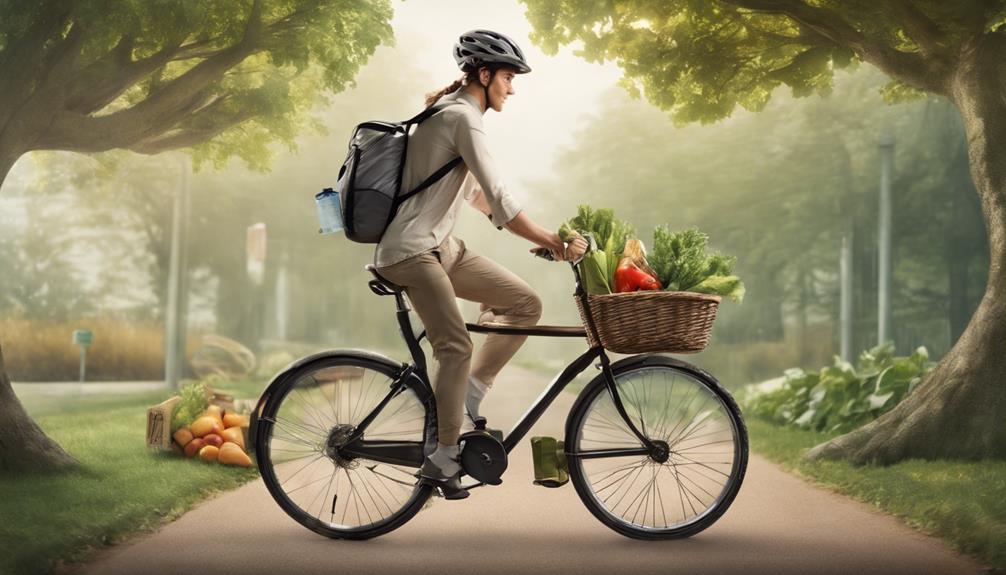
Bicycles, as an eco-friendly mode of transportation, play a crucial role in reducing pollution and promoting environmental sustainability. Riding a bike isn't only environmentally friendly but also offers numerous health benefits. Compared to vehicle passengers, cyclists inhale less pollution, contributing to better overall health. Commuting by bike significantly reduces the transportation carbon footprint by 67%, making it a sustainable choice for those concerned about environmental conservation.
In urban areas, where congestion and emissions are pressing issues, bikes provide a cleaner and healthier transportation option. By choosing to cycle instead of drive, individuals can actively help to reduce emissions and alleviate traffic congestion. Cycling not only benefits the individual rider but also contributes to a cleaner environment for all. Embracing bicycles as a means of transport is a step towards creating a more sustainable and eco-conscious society.
Cost-Effective Transportation Solution

Cycling offers an economic travel option for individuals seeking a budget-friendly commuting choice. By opting for a bicycle, we can enjoy an affordable way to travel that saves us money on fuel, insurance, and parking fees.
The minimal maintenance costs of bicycles compared to cars make them a cost-effective transportation solution for daily commuting needs.
Economic Travel Option
Embracing two-wheeled travel offers a budget-friendly and efficient way to navigate urban landscapes, saving on various transportation expenses. Cycling as an economic travel option not only helps in avoiding traffic congestion and parking expenses but also reduces the overall cost of commuting compared to owning a car. Bicycling serves as a cost-effective mode of transportation, cutting down expenses on fuel, registration, insurance, and maintenance. Furthermore, it promotes physical fitness, eliminating the need for costly gym memberships. By choosing bicycles for transportation, individuals can enjoy the built-in exercise benefits while minimizing travel costs.
| Benefits | Description |
|---|---|
| Cost-Effective | Saves money on fuel, registration, insurance, and maintenance. |
| Traffic Congestion | Helps in avoiding congested roads, leading to faster and more reliable travel. |
| Parking Expenses | Eliminates the need for expensive parking fees in urban areas. |
| Physical Fitness | Promotes health and wellness through regular physical activity. |
| Built-in Exercise Benefits | Provides exercise benefits while commuting, reducing the need for a separate gym membership. |
Budget-Friendly Commuting Choice
Navigating urban landscapes on two wheels presents a budget-friendly and efficient means of transportation, offering significant savings on various commuting expenses. Commuting by bike is a cost-effective option that helps individuals save money on fuel, maintenance, insurance, and registration fees.
Choosing a bicycle for commuting is an economical mode of transport, reducing overall transportation expenses and avoiding the high costs associated with car ownership. Cycling as transportation provides significant savings over time, making it a wise financial decision for those looking to cut down on commuting costs.
Affordable Way to Travel
When considering cost-effective transportation solutions, utilizing bicycles emerges as a practical and economical choice for travel. Cycling is an affordable way to travel, significantly reducing transportation costs compared to owning and maintaining a car. Here are some key points highlighting why cycling is a budget-friendly and practical option for travel:
- Bicycles are a cost-effective mode of transportation, saving money on fuel, registration, insurance, and maintenance.
- Using a bicycle for transportation helps avoid expenses associated with car ownership, making it a budget-friendly option.
- Bicycles provide an economical travel solution, minimizing the financial burden of fuel prices and maintenance fees.
- Choosing a bicycle for transportation is a practical and affordable option that contributes to overall cost savings.
Physical Fitness Improvement

Cycling offers a substantial boost to our physical fitness levels by targeting key muscle groups and enhancing cardiovascular health. It's a low-impact exercise that strengthens the legs and improves balance, coordination, and posture.
Regular cycling sessions can help improve stamina, endurance, and overall cardiovascular function, making it a fantastic workout choice for individuals of all fitness levels.
Health Benefits
Improving physical fitness through cycling offers a range of benefits, including strengthening leg muscles, enhancing balance, posture, and coordination, and targeting key muscle groups such as quads, glutes, hamstrings, and calves.
Cycling is a low-impact exercise option that's gentle on the body and enhances cardiovascular function and overall fitness levels. It provides a time-efficient way to get fit and replace sedentary time with healthy exercise, benefiting individuals of all ages.
Regular cycling strengthens the cardiovascular system, enabling more exercise with less effort, and helps individuals achieve physical activity guidelines effectively. Adults cycling use 10 times more oxygen than sitting, promoting respiratory health by making the lungs work harder and delivering more oxygen where it's needed.
Cardiovascular Workout
Enhancing cardiovascular fitness through regular cycling contributes significantly to overall physical well-being and health. Cycling provides an effective cardiovascular workout, strengthening the heart, improving blood circulation, and lowering blood pressure.
By increasing heart rate, cycling helps improve cardiovascular fitness, reduce the risk of heart disease and stroke, and enhance endurance. This low-impact exercise is gentle on the joints while still offering a challenging workout.
Consistent cycling sessions lead to improved heart health, increased stamina, and enhanced physical fitness levels. Incorporating cycling into a routine not only benefits the heart but also contributes to overall well-being by boosting fitness and lowering the risks associated with a sedentary lifestyle.
Stress Reduction and Mental Wellbeing

Stress levels can be effectively reduced and mental well-being promoted through the scientifically proven benefits of cycling. Cycling isn't just a physical activity; it also has significant positive effects on mental health. Here are some key ways cycling contributes to stress reduction and mental well-being:
- Cycling releases endorphins, known as 'feel-good' hormones, which help reduce stress, anxiety, and depression.
- Regular cycling boosts brain function, enhances cognitive abilities, and improves overall mental health.
- Engaging in cycling stimulates blood flow to the brain, aiding in relaxation, focus, and concentration.
- Studies show that cycling is as effective as medication in reducing stress and promoting a positive mindset.
Community Connection and Social Interaction

Cycling not only promotes physical health but also nurtures a sense of community and encourages social interactions among individuals with shared interests. Riding a bicycle creates opportunities for community connection and social engagement through various avenues such as cycling clubs, group rides, and cycling events. Cyclists often come together to share their passion for biking, meet new people, make friends, and form lasting bonds.
| Community Connection | Social Interaction |
|---|---|
| Cycling clubs provide a platform for cyclists to engage with like-minded individuals. | Group rides offer a chance to connect with others while enjoying the thrill of cycling. |
| Community bike events, like charity rides or cycling festivals, foster an inclusive environment for cyclists. | Participating in cycling events allows cyclists to meet new people and form friendships based on their shared love for biking. |
In these settings, individuals find a supportive community that not only values their shared interest in cycling but also encourages social connections and interactions.
Sustainable and Green Lifestyle Choice

Choosing to ride a bicycle aligns with sustainable living practices and reduces our reliance on non-renewable resources. Bicycles are a sustainable transportation choice, producing zero emissions and reducing the carbon footprint. Opting for cycling helps create a greener environment by decreasing air pollution and harmful emissions. Cycling promotes a green lifestyle by minimizing the use of fossil fuels and contributing to cleaner air.
It's an eco-friendly mode of transport that supports the preservation of natural resources and aligns with sustainable living practices. By choosing bicycles over cars, we actively participate in reducing our carbon footprint and promoting green transportation. Embracing cycling as a sustainable and green lifestyle choice not only benefits our health but also plays a significant role in preserving the environment for future generations.
Let's pedal towards a more sustainable future together.
Frequently Asked Questions
What Can Bicycles Be Used For?
Bicycles can be used for commuting to work, school, or other destinations, reducing reliance on cars and public transportation. They are ideal for recreational purposes such as cycling tours, exploring nature trails, or participating in cycling events.
How Does the Bicycle Help Society?
Cycling weaves our urban tapestry with threads of health, community, and sustainability. Bicycles untangle traffic knots, paint green strokes on carbon clouds, and pedal us into a brighter, closer-knit future.
How Was the Bicycle Important?
The bicycle was crucial throughout history, revolutionizing transportation, empowering women, boosting economies, and promoting public health. Its impact continues to be felt worldwide, providing reliable transport and fostering physical activity, making it a truly enduring invention.
How Do Bikes Help the Environment?
Cycling, like a green breeze, helps the environment by reducing carbon emissions and air pollution. Bicycles are a sustainable transportation choice, cutting down our carbon footprint significantly compared to driving, contributing to cleaner air quality.
Conclusion
In conclusion, cycling offers a multitude of benefits for our health, the environment, and our wallets.
Did you know that cycling just 20 miles a week can reduce the risk of heart disease by 50%?
With its ability to improve physical fitness, mental well-being, and community connections, biking is truly a valuable and enjoyable way to stay healthy and happy.
So grab your helmet and hit the road for a sustainable and rewarding lifestyle choice!
Olivia’s writing is not only informative but also inspiring. She has a knack for telling stories that capture the essence of cycling and the joy it brings to people’s lives. Her writing has been praised by readers and industry experts alike for its clarity, depth, and authenticity.
In addition to her writing, Olivia is also an avid cyclist. She enjoys exploring new trails and routes and has participated in several cycling events and races. Her first-hand experience with cycling gives her a unique perspective on the sport, reflected in her writing.
Overall, Olivia is a talented writer passionate about cycling and dedicated to producing high-quality content for FlatironBike. Her contributions to the magazine have helped make it a go-to source for cycling enthusiasts worldwide.
Beginners Guides
What Are the Basics of How a Bicycle Freewheel Works?
Leveraging intricate mechanisms, bicycle freewheels allow wheels to spin freely—discover the fascinating basics and functions behind this essential component.

When we hop on our bicycles, we often take for granted the intricate workings of the freewheel in the rear hub. Did you know that the freewheel plays a vital role in allowing the wheel to rotate independently of the pedals?
Understanding the mechanisms behind how a bicycle freewheel operates can provide valuable insight into the smooth functioning of this essential component. Let's explore the inner workings of different types of freewheels and uncover the basics of their functionality to gain a deeper appreciation for this often overlooked yet crucial part of our bikes.
Key Takeaways
- Pawls and ratchets enable torque transmission and wheel movement.
- Ratchet and pawl mechanism ensures smooth power transfer and rider flexibility.
- Star ratchet freewheels offer robust construction and reliability on challenging terrains.
- Roller freewheels use ball bearing design for durability and smooth operation.
Components of a Bicycle Freewheel
In a bicycle freewheel, the components responsible for transmitting torque and facilitating forward pedaling are the pawls and ratchets. The ratchet and pawl system in the freewheel is integral to its function.
The pawls, small spring-loaded components, engage with the ratchet's teeth to allow the wheel to turn when the pedals are in use. This interaction forms the basis of the drive system, enabling the transfer of power from the rider's pedaling to the wheel.
The star ratchet design within the freewheel ensures that the pedals remain stationary when the wheel is spinning freely, preventing any unwanted backward rotation. When coasting or not pedaling, the pawls disengage from the ratchet, allowing the wheel to rotate independently without resistance.
This intricate mechanism of pawls and ratchets in the freewheel guarantees a smooth and efficient forward motion while offering the rider the freedom to pedal without constraint.
Ratchet and Pawl Mechanism Explained

Exploring the inner workings of a bicycle freewheel reveals the intricate and efficient system known as the ratchet and pawl mechanism. This mechanism plays a crucial role in enabling torque transmission and facilitating the forward movement of the bicycle.
Here's a breakdown of its key components:
- Ratchet and Pawl Interaction: The pawls engage with the teeth on the ratchet, allowing the wheel to move forward when the pedals are in motion.
- Disengagement for Free Movement: When the pedals are reversed, the pawls disengage from the ratchet, enabling free movement without propulsion.
- Spring Mechanism for Torque Transmission: A spring mechanism within the system ensures that the pawls engage effectively with the ratchet to transmit torque seamlessly.
- Audible Click Feature: The characteristic click sound heard when reversing pedals signifies the engagement and disengagement of the pawls with the ratchet.
This precise and reliable design ensures that the bicycle freewheel operates smoothly, providing efficient power transfer while maintaining the flexibility and freedom desired by cyclists.
Understanding Star Ratchet Freewheels

Amid the realm of bicycle freewheel mechanisms, star ratchet freewheels stand out for their robust construction and enhanced durability. Consisting of two toothed discs with slanted teeth pressed together by a spring during pedaling, these freewheels excel in demanding riding conditions like freeride and downhill.
When idling, the toothed discs in star ratchet freewheels move against each other, creating a characteristic noise that provides riders with distinct auditory feedback. This noise is a result of the discs moving against each other, signifying the reliability and durability of this freewheel mechanism.
The robust nature of star ratchet freewheels makes them a preferred choice for riders tackling challenging terrains, especially when going downhill. The enhanced durability of these freewheels ensures that riders can trust their rear wheel's performance even in the most demanding situations, offering a sense of freedom and confidence while riding.
Inner Workings of Roller Freewheels

Utilizing pinch rollers that are pressed against the hub during pedaling, roller freewheels propel the bicycle forward with efficiency and minimal noise. The inner workings of roller freewheels involve a sophisticated design that ensures seamless functionality.
Here's a closer look at how roller freewheels operate:
- Pinch Roller Mechanism: Pinch rollers are key components that make direct contact with the rear sprocket, transferring power efficiently during pedaling.
- Guide Tracks: These rollers move freely within guide tracks when coasting, resulting in a noiseless riding experience.
- Ball Bearing Design: Similar to ball bearings, roller freewheels are designed for smooth and quiet operation, enhancing the overall riding experience.
- Durability and Reliability: Roller freewheels are renowned for their durability and long service life, making them a dependable choice for riders seeking a silent ride.
The meticulous engineering behind roller freewheels ensures smooth engagement under load and quiet operation while coasting, offering riders the freedom to enjoy a peaceful cycling experience.
Functionality of Sprag Clutch Freewheels
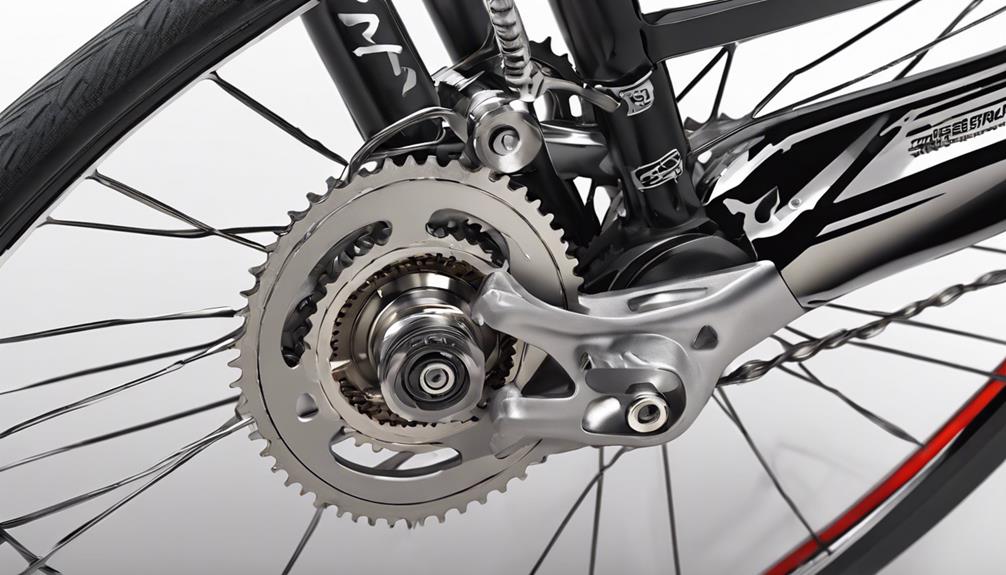
Sprag clutch freewheels employ sprags to facilitate torque transmission within bicycles, ensuring efficient power transfer. When the cyclist stops pedaling, the sprags disengage, allowing the wheel to spin freely without moving the pedals. The design of sprag clutch freewheels enables smooth engagement and disengagement, leading to efficient power transfer when pedaling resumes. The instant engagement of the sprags ensures quick and responsive power delivery, enhancing the overall riding experience.
Due to their simple yet effective design, sprag clutch freewheels require minimal maintenance. Cyclists can enjoy reliable performance in various riding conditions without the need for frequent adjustments or repairs. The durability and functionality of sprag clutch mechanisms make them a popular choice among cyclists seeking consistent and hassle-free operation. Whether navigating city streets or tackling rugged terrains, sprag clutch freewheels provide the necessary torque transmission for a smooth and enjoyable ride.
Frequently Asked Questions
How Does a Bicycle Freewheel Work?
We know how a bicycle freewheel works. It allows pedals to rotate independently from the rear wheel, ensuring smooth coasting. The mechanism engages during forward pedaling and disengages when coasting or backpedaling, playing a vital role in efficient cycling.
What Is the Principle of Freewheel?
Freewheeling is akin to a river flowing, allowing us to move forward effortlessly. The principle of a freewheel is to enable coasting by disconnecting pedals from the wheel, granting us the freedom to control our speed effortlessly.
What Is the Free Wheeling Technique?
Freewheeling technique on a bicycle involves coasting without pedaling, allowing riders to conserve energy and maintain momentum. It's crucial for controlling speed and balance during descents, enhancing the overall riding experience.
What Is the Difference Between a Freewheel and a Freehub?
We differentiate between a freewheel and a freehub by their attachment methods to the hub and compatibility with sprocket configurations. Freewheels thread onto hubs with a lockring, while freehubs use a splined interface for cassettes, offering more versatility.
Conclusion
In conclusion, the bicycle freewheel is a marvel of engineering, allowing for seamless transmission of power while enabling the wheel to rotate independently of the pedals.
Its intricate mechanisms, such as the ratchet and pawl, star ratchet, roller, and sprag clutch, work in harmony to provide cyclists with a smooth and efficient riding experience.
The freewheel is like a symphony of precision, orchestrating the dance between pedal power and wheel rotation with unparalleled grace and finesse.
Olivia’s writing is not only informative but also inspiring. She has a knack for telling stories that capture the essence of cycling and the joy it brings to people’s lives. Her writing has been praised by readers and industry experts alike for its clarity, depth, and authenticity.
In addition to her writing, Olivia is also an avid cyclist. She enjoys exploring new trails and routes and has participated in several cycling events and races. Her first-hand experience with cycling gives her a unique perspective on the sport, reflected in her writing.
Overall, Olivia is a talented writer passionate about cycling and dedicated to producing high-quality content for FlatironBike. Her contributions to the magazine have helped make it a go-to source for cycling enthusiasts worldwide.
-

 Electric Bike3 months ago
Electric Bike3 months agoHow To Turn Your Bike Into An Electric Generator
-

 Bike2 months ago
Bike2 months agoAdvantages and Disadvantages of a Carbon Fiber Bike Frame
-

 Beginners Guides2 months ago
Beginners Guides2 months agoA Guide to Right Hybrid Bike Posture: How to Sit on the Bike for Optimal Performance
-
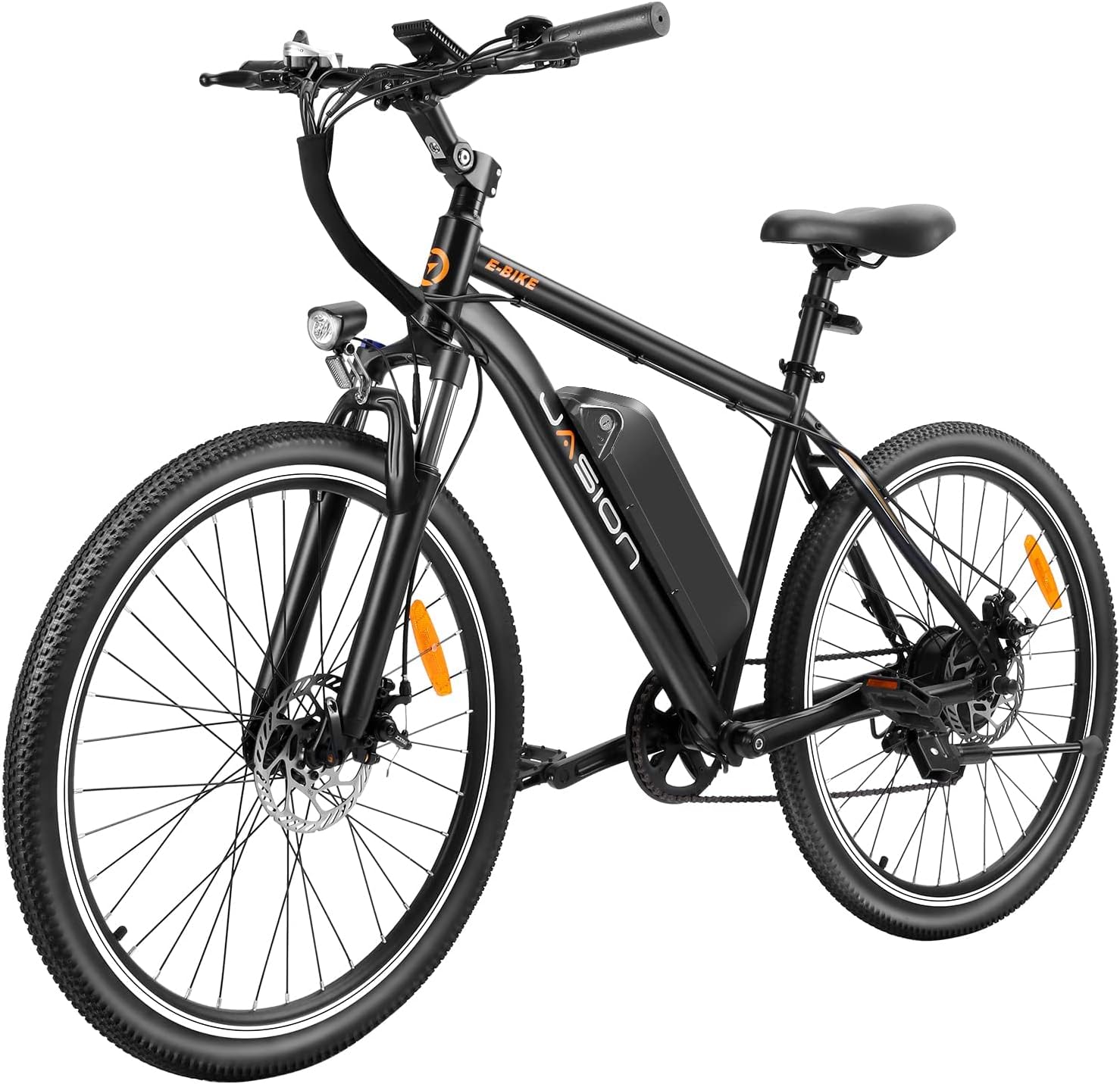
 Vetted3 months ago
Vetted3 months agoJasion EB5 Electric Bike Review: Commute Mountain Bike for Adults
-
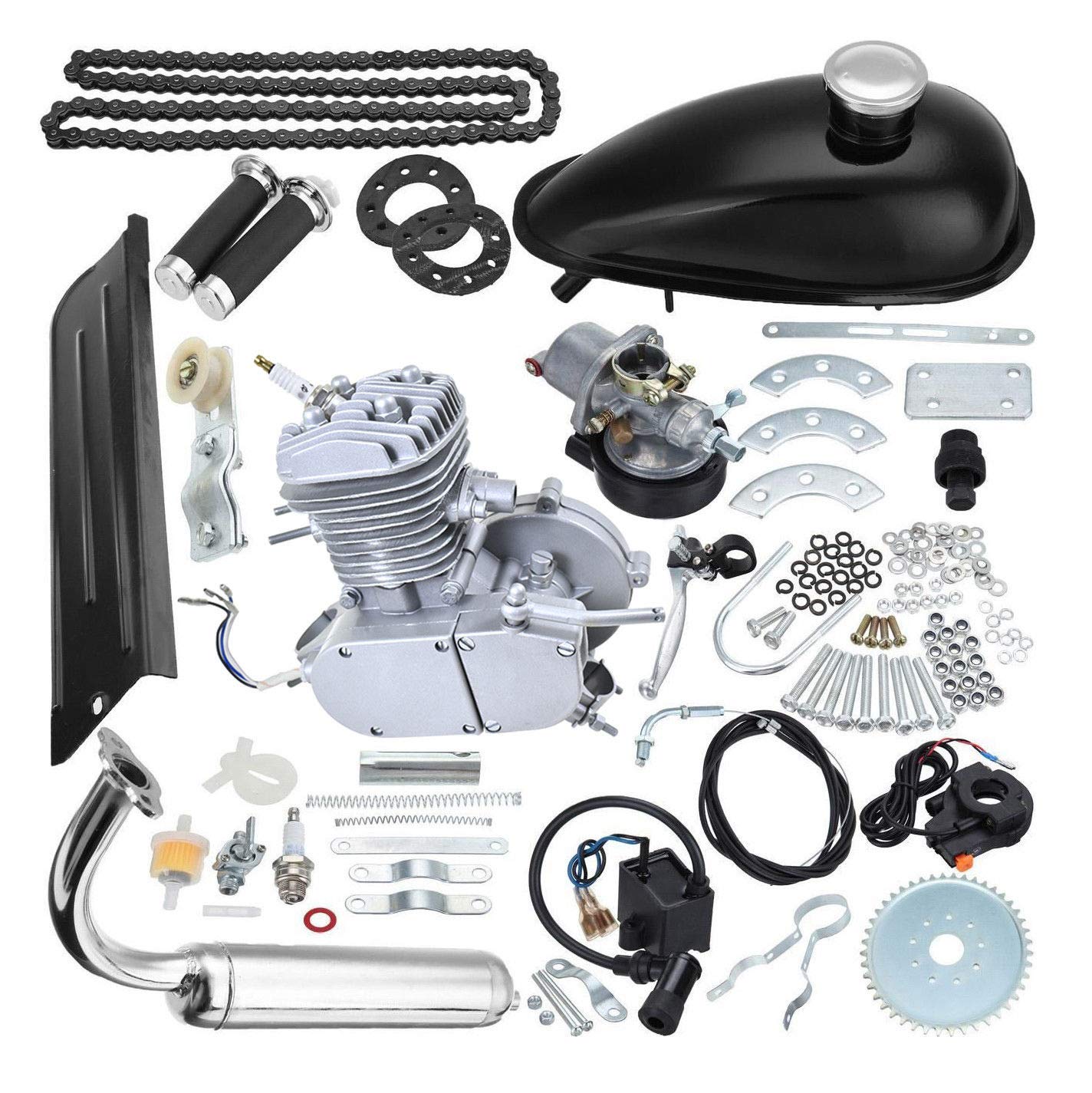
 Vetted3 months ago
Vetted3 months agoReview: 80CC Motorized Bicycle Gas Engine Kit with Performance Carburetor
-

 Vetted2 months ago
Vetted2 months ago12 Best Men's Cycling Bib Shorts for Comfort and Performance – Reviewed & Rated
-

 Beginners Guides2 months ago
Beginners Guides2 months agoWhere Are KTM Motorcycles Made?
-

 Vetted3 months ago
Vetted3 months agoFREESKY Electric Bike Review: 1000W Motor, 48V Battery, Full Suspension













